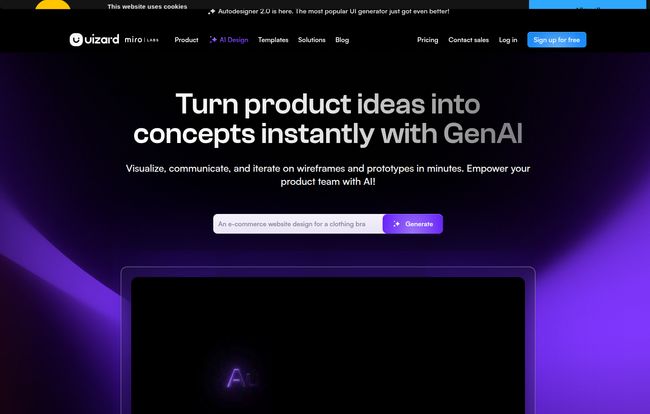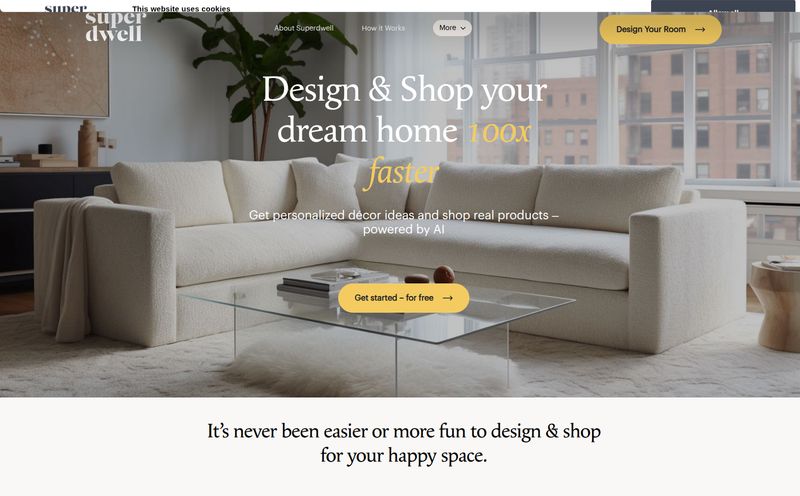I’ve been in the marketing and SEO trenches for a long time. Long enough to remember when 'responsive design' was a revolutionary concept and not just, you know, table stakes. I've wireframed on napkins, built mockups in PowerPoint (don't judge), and spent more hours than I care to admit nudging pixels in more 'professional' tools. It's a grind. The back-and-forth between idea and tangible mockup can kill momentum faster than a 10-person committee trying to name a product.
So, when I first heard about Uizard, an AI-powered UI design tool, my inner skeptic raised an eyebrow. AI? Designing an app? Sure. And my Roomba is about to paint the Sistine Chapel. But then I tried it. And folks, I've got to say... the robots are getting pretty darn good at this.
So, What Exactly Is Uizard?
Forget the jargon for a second. At its heart, Uizard is like a design co-pilot. It’s not about replacing designers—a point I’ll come back to—but about massively speeding up the early stages of creation. It’s a tool designed to turn your thoughts, prompts, and even your chicken-scratch drawings into clean, functional, and editable digital designs. Instantly.
Think about the last time you had a great idea for an app or a new website feature. What happened next? You probably tried to explain it in a Slack message, draw it on a whiteboard, or wrestle with a complex design program. Uizard aims to short-circuit that entire frustrating process. It's built for speed and for people who aren't necessarily seasoned UI/UX professionals, like founders, product managers, and marketers like me. It makes design accessible.

Visit Uizard
The AI Magic Wand: Uizard's Best Features
Okay, let's get into the good stuff. What does this thing actually do? It’s not just one trick, it's a whole bag of them.
Autodesigner: From a Text Prompt to a Full UI
This is the main event. The feature that makes you go, “whoa.” You type a description of an app—say, “a clean, minimalist mobile app for tracking house plants, with a login page, a dashboard showing my plants, and a page to add a new plant”—and you click a button. Uizard’s AI chews on it for a minute and then… poof. It spits out a multi-screen mockup. It's not always perfect, but it’s a stunningly effective starting point. It gets you from zero to sixty percent done in about 90 seconds. From there, you can tweak, edit, and refine everything. Its a wild experience the first time you see it work.
Screenshot Scanner: The Ultimate 'Steal Like an Artist' Tool
Ever see a feature on another app or website and think, “I want something like that, but different”? We all do it. The Screenshot Scanner is built for this. You can upload a screenshot of any interface, and Uizard’s AI will convert it into a fully editable mockup in your project. It's an incredible tool for inspiration and iteration. You can grab a login screen you like, import it, and then immediately start changing the colors, fonts, and layout to match your brand. No more trying to recreate it from scratch.
From Napkin Sketch to Digital Reality
This one feels like something out of science fiction. You can literally draw a rough wireframe of a screen on a piece of paper, take a picture of it with your phone, and upload it. Uizard will analyze your drawing and transform it into a digital wireframe. Is the handwriting recognition perfect? Not always, but it’s shockingly accurate for basic layouts. For anyone who thinks better with a pen in their hand, this is a bridge from the analog world to the digital one.
Who is Uizard Actually For?
This is a big question. Is this the tool that will finally make Figma or Sketch obsolete? Honestly, no. And I don’t think it’s trying to be. High-end, pixel-perfect design systems for massive corporations will likely still be built by specialized teams in those established tools.
But that's not the point. Uizard is for the rest of us. It's for:
- Startup Founders who need to create a convincing prototype for investors, fast.
- Product Managers who want to quickly visualize a new feature for their dev team without a week-long design cycle.
- Marketers and SEOs who need to mock up a new landing page for a campaign without pulling a designer off a more critical project.
- Developers who can handle the code but dread the front-end design part. This gives them a massive head start.
It democratizes the initial phase of design. It’s for moving quickly, testing ideas, and getting everyone on the same page visually. It's for people who value speed and collaboration over granular, pixel-level control in the early stages.
The Big Question: Uizard Pricing
Alright, let's talk money. Tools like this are only useful if they're accessible. Uizard has a pricing structure that seems pretty well thought out for its target audience. I've broken it down into a simple table.
| Plan | Price | Best For | Key Features |
|---|---|---|---|
| Free | $0 | Students, Hobbyists, Testing | 3 AI generations/month, 2 projects, 10 templates |
| Pro | $12/month (billed annually) | Startups & Small Teams | 500 AI generations/month, more powerful AI, developer handoff, up to 100 projects |
| Business | $39/month (billed annually) | Larger Organizations | 5,000 AI generations, custom brand kit, unlimited projects, priority support |
| Enterprise | Custom | Large-scale Deployment | Unlimited everything, custom setup, dedicated support |
In my opinion, the Pro plan is the sweet spot. The free plan is great for a test drive, but you'll burn through those 3 AI generations pretty quick once you see what it can do. At $12 a month, getting 500 generations and the ability to hand off code to developers is an absolute steal for any serious project.
The Good, The Bad, and The AI-Generated
No tool is perfect, especially one on the cutting edge of AI. I believe in giving an honest take, not just a sales pitch.
The best parts are obvious: the speed is just insane. The ability to generate ideas out of thin air is a cure for blank-page syndrome. It's incredibly user-friendly; if you can use a word processor, you can use Uizard. And the real-time collaboration is smooth, making it easy to work with a team.
But there are downsides. The AI, while impressive, can sometimes produce... funky results. It's an assistant, not a master artist. You'll still need a human eye to refine things. And of course, to get the most out of it, you need to be on a paid plan. This reliance on AI also means you're giving up some of teh fine-grained control you'd have in a traditional tool. For some designers, that will be a dealbreaker. For product people like me, it's a worthwhile trade-off for the velocity it provides.
My Final Verdict: Should You Use Uizard?
Look, the conversation around AI in creative fields is full of hype and fear. But Uizard feels like one of the most practical and genuinely useful applications I've seen yet. It doesn't feel like a threat; it feels like a powerful new type of tool in the toolbox.
Should you use it? If you're a startup needing to iterate quickly, a PM trying to communicate ideas better, or a marketer wanting to build landing pages without the bottleneck... absolutely. Give the free plan a spin. I promise you, the first time you watch it turn a sentence into a screen, you'll feel that little jolt of the future.
It’s not here to replace great designers. It’s here to make everyone else more capable of design.
Frequently Asked Questions about Uizard
- 1. What is Uizard best used for?
- Uizard excels at rapid prototyping, wireframing, and generating initial design ideas for mobile apps, websites, and digital products. It's ideal for the early stages of a project where speed and idea visualization are more important than pixel-perfect final designs.
- 2. Is Uizard really free?
- Yes, Uizard has a generous free plan that's great for students, hobbyists, or anyone who wants to try out the platform. It includes core features but has limits on the number of projects and AI generations per month.
- 3. Can Uizard replace a human designer?
- In my view, no. Uizard is a powerful assistant, not a replacement. It automates the tedious parts of early design, but it still requires human creativity, taste, and strategic thinking to refine the AI's output into a polished, user-centric final product.
- 4. How good is the AI in Uizard?
- It's surprisingly good, especially for generating structured layouts and standard UI components. It's not a sentient artist—it can sometimes misinterpret prompts or create slightly generic designs—but it provides a fantastic starting point that is 80% of the way there in seconds.
- 5. Does Uizard export to code?
- Yes, the paid plans (Pro and above) offer a developer handoff feature that can export designs to React with CSS, which can be a significant time-saver for development teams.
Conclusion
In a world full of tools that promise to 'revolutionize' your workflow, Uizard is one of the few that actually feels like it might. It's a bridge between imagination and execution, powered by some seriously clever AI. It’s not perfect, but it is fast, fun, and genuinely useful. For anyone involved in creating digital products, it's a tool you need to have on your radar. Go give it a try.



